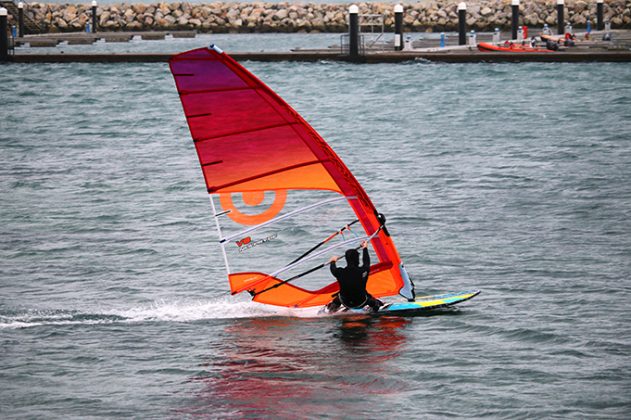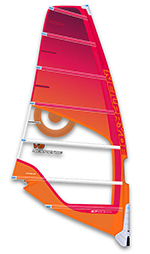
NEIL PRYDE V8 7.7M 2017 TEST REVIEW
NEIL PRYDE V8 7.7M 2017 TEST REVIEW
OVERVIEW
The V8 was introduced midway through the 2016 season, taking over from the twin-cam Hornet in the Neil Pryde range. Classed as a ‘performance freeride’ sail, capable of being partnered with everything from freeride to freerace and slalom boards, it is designed to provide “extra power and drive” combined with a lightweight configuration for easy handling during manoeuvres. Tested here on an SPX95 SDM mast, it is easy to rig, the movement in the luff sleeve due to the zipped pockets enabling the cams to pop onto the mast effortlessly. Once downhauled fully, the V8 displays a moderate amount of depth to its profile, locked well forward in the draft, whilst the leech falls away smoothly. Apply more tension and the leech opens further, whereas the draft’s depth only flattens marginally. It has got to be said – the V8 is a pretty looking sail, without a blemish or crease in its panels. The finishing touches also ooze quality, from the integrated downhaul rope clip in the tack roller pulley, to the Kevlar laminates that strengthen the brand’s clew to house their dual boom length concept.
BRAND CLAIM
“On the new V8 I merged the advantages of [a] wide, race inspired luff sleeve design and a deep powerful profile with soft rotation, easy rigging and light weight made possible by the Integra-cam. The result is incredible acceleration from [the] get-go, excellent middle wind range top speed and upper-end camber-supported profile stability.”
PERFORMANCE
Whether it’s the fact that it’s the only true twin-cam in the group or down to its geometry and design, the V8 is certainly one of the lighter handling and more capable sails in marginal conditions. Setting with plenty of shape locked forward in its draft, the power is precise and balanced in the hands, the flex and response in the mast providing a tangible punch forward as the sail is pumped. It quickly settles into a secure and comfortable stance, pinning the board down whilst retaining crispness to its nature that belies its size. It feels the smallest in the group, and yet generates every bit of power that you’d expect of a 7.7m. This light, poised character is also evident in transitions – entering at speed, the rider always enjoys a sense of where the sail’s power is and how to use it most effectively. Rotation in transition is certainly positive, bordering on stiff, yet get used to it and it can be used to great effect in the exit, before pumping and accelerating away from the field. As the wind increases the V8 can be re-tuned with more downhaul tension, releasing the lower leech and extending the visible twist in the sail. It is certainly fast on the reaches and playing the two clew eyelets to alter the feedback also works extremely well. It may not have the ultimate top end looseness and extra gear of a few more specialist thoroughbreds here, but the V8 demonstrates just what a twin cam is capable of. With one foot firmly placed in the brand’s race programme, its all-round performance has eclipsed its predecessor, whilst still exhibiting the true upside of handling and simplicity that twin-cams are noted for.
THE VERDICT
All-round performance that is hard to beat. Easy to rig, the V8 combines power and precise balanced handling over an impressive range, and a turn of speed that most race specialist sails would be content with.
Other sails in this test:


